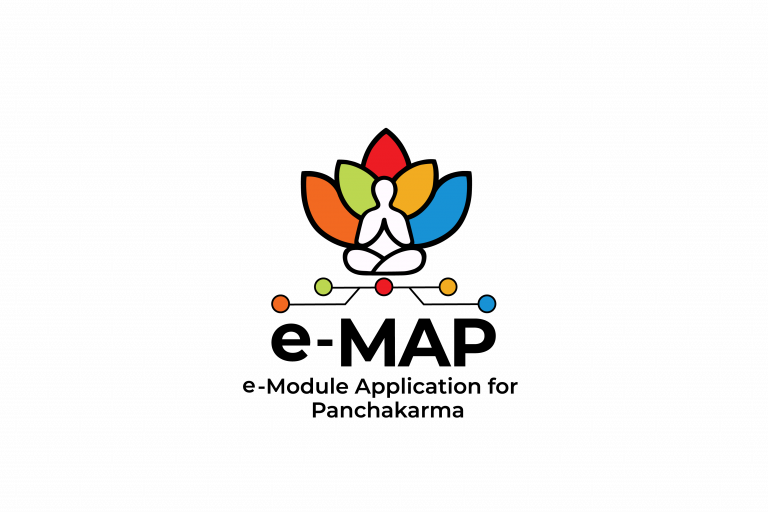
PG Module 3
SVEDANA

EXPLANATORY NOTES
Materials: Mud pot, stem of Vamśa, Arka, Eranda or Karanja;dimensions – length of Stem – Gajāgrahasta(6 ft)
Drugs used:Vāta-KaphaRōga – Varuņa, Guďūci, Šigru, Mūlaka,Sarṣapa, Vāsā, Vamśa, Karanja, Aśmantaka, Mālati, Tulasi, BrihatPancamūla
PittänubandhiVāta –Bhūtika, Dašamūla, Surā, Dadhimastu,Mūtra, Amla, Sneha (Ca.Sū.14/33)
Procedure: A mud pot having the capacity of 5-8 liter is taken & then a hole is made at the neck. Stem of Eranda bent at 2-3 places is taken; attach it to the pot where hole is made and sealed properly. The free end of the stem should be covered with the leaf of Eranda& 3-5 holes are made for the passage of steam.
Then add water and above said drugs into the pot and kept over the fire till the mixture gets boiled. Then patient who is anointed withoil is told to sit on a stool. The therapist should hold the stem (Nāḍi) & direct the Sveda (steam) to the affected parts of body; longitudinal movements over the limbs and circular movements over the joint.Care should be taken not to give excess of steam or from near distance which may leads to burn wounds. The procedure should be carried out till the appearance of proper symptoms of Sudation. Currently instead of pot & stem, pressure cooker and plastic pipe is used.
KṣīraDhūmais a NāḍiSveda which is a type of ŪṣmaSveda .The therapeutic efficacy of NāḍiSvedavaries according to the Drava used. Kṣīradhūma is a snigdhaSveda. In NāḍiSveda, a tube of appropriate length attached to an apparatus containing Drava is used to direct the steam appropriately to the area which isto be sudated. In Kṣīradhūma, steam is generated by boiling milk and Balāmūla/ Daśamūla/ Vacākvātha. It is mainly practised in the management of Ardita, Jihvāstambha, Hanustambha, Svarabhaṅga.
Materials required:
- Chair – 1 2. Milk – 500 ml 3. BalāKvātha – 500 ml 4. Oil for Abhyaṅga – 50 ml 5. Oil for Talaṃ – 10 ml (Navanīta+Balācūrṇa) is optional 6. RāsnādiCūrṇa– 5 g 7. NāḍiSveda apparatus – 1pot covered with leaf, pressure cooker 2 – 3 litre
Rubber tube – 2metre. Gauze piece at end of mouth of tube to avoid spilling.
- Lotus petals – Q.S. 9. Blanket – 1 10.Cotton towel – 1 11. Cloth for wrapping eyes – 1 12. Attendant – 1
Preparation of medicine:
BalāKvātha: 500g of crushed Balāmūlais boiled with 2 litres of water & 500ml of milk and reduced to 500ml.This is used to generate steam for the therapy.
Pre-operative procedure:
Patient should be seated in a chair and Talaṃshould be applied with suitable oil. Abhyaṅga should be done over face, fore head, neck, shoulder& chest. The eyes should be covered with cotton cloth after placing lotus petals over both lids. The head and neck portion is covered from the back with a blanket.
Procedure:
The patient should sit comfortably for the procedure. Then steam from the apparatus is directed over face, neck, chest& shoulder. Special care should be taken to avoid burns and to get uniform steam. The procedure should be continued up to the appearance of sweat. It is done for about 5-15 minutes. Intermittent opening of the mouth is to be done.
Post-operative procedure:
Lotus petals are removed from the eyes and sweat is wiped off with a soft towel. Talaṃ is to be removed and RāsnādiCūrṇashould be applied. Kavala or Gaṇḍūṣashould be done with proper medicines. The patient should take complete rest.
Precautions:
- Eyes should be tied to protect them from heat.
- Move the pipe of Svedana apparatus frequently to avoid burns.
- Preferably done in morning hours in moderate climate.
Complications and management:
Fainting– Take appropriate measures.
Burns –Apply Ghṛta, preferably ŚatadhaḥutaGhṛta.
Indication: Ardita, Jihvāstambha, Hanustambha, Svarabhaṅga
The word ‘Avagāha’ means to immerse. AvagāhaSveda is a type of sudation therapy which is included in Drava Sveda, in which the patient is made to sit/lie in a tub containing medicated Drava Dravyato produce fomentation to the body.
Materials required:
- Bath tub (5.6ft X 2.6ft X 1.4ft) – 1
- Vessels – 2
- Suitable Drava Dravya – 40 – 60 litres (Sarvāṅga)/10 – 15 litres (AdhaḥKāya)
- Oil for Abhyaṅga – 100 ml
- Oil for Talaṃ- 10ml
- Cūrṇa forTalaṃ- 5g
- Towel/tissue Paper – 1
- Attendant – 1
Preparation of medicine:
According to the disease condition suitable Drava Dravyais selected. It should be poured into the tub with a temperature preferably 38oC-42oC.
Pre-operative procedure:
Talaṃ should be kept over the head with suitable oil and Cūrṇa. Abhyaṅga should be performed with prescribed medicated oil around the umbilicus up to the thighs or all over the body according to the condition. It can be performed without Abhyaṅgain certain conditions.
Procedure:
The patient should be seated comfortably in the tub containing medicated Drava Dravyain such a way that his lower part of the body should be submerged above the level of umbilicus. SarvangaAvagāhaSveda should be performed submerging the body up to neck.
When the temperature of the medicated Drava Dravyacomes down, some amount should be replaced by warm Drava Dravya, thus keeping the temperature uniform.
Post-operative procedure:
After the prescribed time, patient must be told to come out and body should be wiped with tissue paper or towel. Talaṃ should be wiped off using dry towel and apply
Prescribed Cūrṇaslike RāsnādiCūrṇa/ KaccūrādiCūrṇa. He is advised to take rest for half to one hour, and then to bath with lukewarm water.
Precautions:
- Therapy should be stopped at any time if the patient gets good perspiration.
- The temperature of the Drava Dravyashould be maintained between 38oC-42oC.
Complications and management:
- 1. Fainting – Due to increased body temperature or low heat threshold of patient or atiyoga of Kriya Krama. Sprinkling cold water on face and body; providing sufficient water supplement or DrākṣādiKaṣāya are useful in this condition.
- Burns – Due to heat intolerance of patient or excessive heat of Drava. Apply Madhu and Ghṛtapreferably ŚatadhaḥutaGhṛta.
Indications:Arśas, Mūtrākrichra, Kaṭīśūla, Asmari



